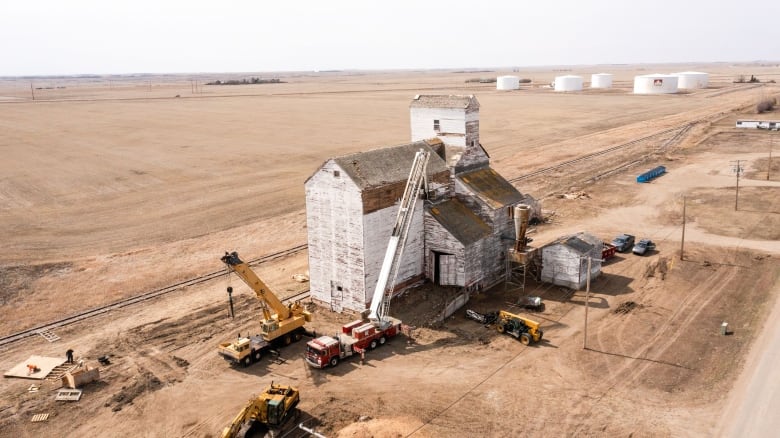
Entering one of the three grain elevators that stand like giants over Kenaston, Sask., is like walking into a museum.
Old-growth wood houses machinery from another era and rickety lifts with a dusty rope lead to the top of the 30-metre-tall tower.
Rural landmarks like this one are on track to be nearly wiped from Saskatchewan’s map. They fall into disrepair — and subsequently fall victim to fire — or become more expensive to maintain than they’re worth, leading owners to topple them.
But Alvin Herman looks at each weathered board as having potential beyond the landfill.
“I just found myself allergic to demolition and burning and polluting the environment,” the 75-year-old retired farmer and self-proclaimed workaholic said.

His first project was dismantling a 111-year-old elevator he owned himself in Milden, Sask., a village about 90 kilometres southwest of Saskatoon.
Herman said the elevator was “past its best-before-date” and had become a liability to the town and his kids, for its potential safety issues and as a breeding ground for pests.
But Herman, 75, wasn’t willing to give up the thousands of feet of lumber that made up the elevator.
That idea ballooned into ABMT Wood Solutions: a team on a mission to deconstruct grain elevators and repurpose their wood into construction materials and affordable housing.
“We offer them a salvation that isn’t burning,” said Herman.
The team is now picking apart two of the three elevators in Kenaston, 85 kilometres east of Milden.

Herman said ABMT Wood Solutions has about 10 more people on their docket wanting their elevators deconstructed.
Environmentally friendly, affordable housing
ABMT says the vast majority of the wood salvaged from the deconstructed towers is reusable and can be turned into anything from a dance floor to decorative furnishings to entirely new homes.
Old-growth wood, which was used to build the elevators, is difficult to obtain. British Columbia, for instance, is deferring the logging of old growth across about 1.7 million hectares of forest.

By repurposing the timber, the company can maintain a low-carbon footprint, said Ian Loughran, a consultant for ABMT who works for Vereco Smart Green Homes, a home design company that touts its energy efficient builds.
“If these elevators were just demolished, they would be partially landfilled and otherwise lit on fire,” he said. That would emit carbon.
AMBT’s approach has the potential to produce net-zero energy homes — a goal the federal government hopes provinces will adopt for their building codes by 2030.
That includes using mechanically laminated timber panels inside that are, according to the team, structurally stronger than conventional wood frame construction.
ABMT is working on a residential three-bedroom show home using these panels.

Standing inside the Kenaston elevator, Loughran motioned to a large wall behind him made of the nail-laminated timber. He said sections like that could be padded with insulation, which could also be made from recycled wood, and be put up “kind of like a Lego kit.” He said the skeleton of a house can be assembled in a couple weeks.
Loughran said it’s one way to create affordable housing across the country at a time when the nation is facing housing shortages, especially in First Nation communities.
Losing landmarks
The three giants that stand guard over Kenaston’s couple of hundred of residents are visible from miles away. The town mayor, Dallas Lowdermilk, called them a major landmark and said it’s a shame they’re coming down.
“Depending on your age, you’ve basically seen them your whole life,” he said. “If I were to win the lottery tomorrow I would buy them and they would stay there.”

Ali Piwowar, an Ottawa-based architect originally from Regina, wrote her master’s thesis on the tangible and intangible cultural heritage of wooden grain elevators in Saskatchewan. She noted how on the flat Prairies, the tall elevators acted as map pins on the horizon.
“Historically there was one at each town — this vertical structure — and that became this icon that there were people, there was a community,” she said.
But as farmers moved to concrete inland terminals, then to steel silos, wooden elevators on land leased from rail companies became obsolete and expensive to maintain.
Oli Remmen, the co-owner of the elevator that is currently being deconstructed in Kenaston, said it cost about $5,000 to $6,000 annually sitting unused.
The National Trust for Canada, a national charity with goals to save heritage places, has listed wooden grain elevators as a nationally endangered place. Piwowar estimates about 20 elevators are lost each year to demolition, fires or natural disasters.
WATCH | Drone captures demolition of Sask. town’s grain elevator:
Trevor Scherman caught the end of an era in the tiny town of Rockhaven, Sask.
Preserving landmarks
There are 11 grain elevators listed as heritage properties in Saskatchewan, though one burned down in 2010, according to the provincial Ministry of Parks, Culture and Sport. Piwowar said it’s difficult to register them as heritage sites if farmers don’t want them designated.
Brent Guy, the owner of the second elevator in Kenaston to be deconstructed, said he considered that option but never heard back from his MLA about it. He looks back fondly on hosting family reunions in town and letting kids go up the lift to get a view of the surrounding area.
“It’s one of the few communities in Saskatchewan with this kind of backdrop. Unfortunately, it comes down to finances,” he said.
Piwowar looked at preserving the elevators by adapting them into community spaces, something that’s been tried in some Saskatchewan communities and in Alberta. But she also appreciates ABMT’s goal of giving people the opportunity to hold onto a piece of Saskatchewan history in a different way.

As Herman walked through the elevator, he ran his hand along one section of wood, indicating it was the bucket elevator leg. Over decades of use, the friction from the grain had sculpted and polished the wood into a unique wave.
“It’s heritage wood. It’s never going to happen again; you’re not going to find this wood anywhere else in the world. If people want to preserve some of the history, this is kind of the last ditch effort to preserve the old sentinels that dotted Saskatchewan,” said Herman.
“I’m hoping that our process actually allows people to buy a piece or own a piece of Saskatchewan’s heritage.”













